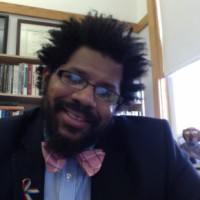Changing the face of American Jesus
In our "Reflections From the Classroom" series, seasoned teachers talk about their experiences walking with students and guiding their learning. This post is the second of two parts showcasing the impact of a unique course taught during January at the Brooks School. Part one introduced Brooks, prep school culture, and the course description for “American Jesus.” Part two delves into various readings, discussions, and student responses to Jesus in the prep school classroom.
Brooks students entered a dated and pretentious room with the feel of an old study. They sat in a circle as they listened to Professor Edward Blum. One lecture illustration was the defaced image of Christ from after the Klan bombed the Sixteenth Street Baptist Church in Birmingham, Alabama. The room transformed as Blum’s slide showed the stained-glass window with a hole where the holy face of Christ had been. Race was briefly absent from this depiction of Jesus. Blum’s talk introduced students to the Jesus used by white supremacy to justify hatred and the killing of four black girls, as well as the Jesus used in the civil rights movement to end Jim Crow. This version of American religion was different from how students at this elite New England boarding school perceived it.
Teaching a course with Jesus in the title is risky here. New England, according to Stephen Prothero, is the least churched culture in the United States. Students who took “American Jesus” often lacked basic religious literacy, making conversations about American evangelical culture a greater challenge than anticipated. The term evangelical evoked suspicion. Often national religious figures such as T.D. Jakes, Joel Osteen, and Rick Warren were unfamiliar to students.
I created a syllabus in which the American construct of Jesus was on trial, allowing students to present their skepticism toward evangelical Christianity. I recognized the value of this personal exploration for students—and for me, as a southern African American navigating a traditional white world of privilege. My journey and the journey of this course had transitioned as I escaped an ideologically conservative institution: my previous school, which sought courses that expressed God’s grace in influencing America’s founding, rather than the free inquiry at the core of “American Jesus.”
Students were asked to discover their own points of view regarding the political nature of God and nation. They greeted John Fea’s Was America Founded as a Christian Nation? with a great degree of gratitude, finding it balanced in constructing a case for each side of this question. Students discussed Fea’s work and talked with him through Skype. He challenged their thinking about the historical forces that established Christianity as the dominant American thought. This also helped with later discussions regarding America’s ideological position in linking Uncle Sam to Jesus Christ. Topics such as printing “In God We Trust” on currency and naming God in the Pledge of Allegiance allowed discussions to shift from the Founding Fathers’ faith to the dawn of the cold war.
James Cone’s The Cross and the Lynching Tree brought us back to race and religion, which students had already encountered with Blum's The Color of Christ. Cone connects Christ’s suffering to the oppression and suffering of African Americans, distancing the white supremacy of American Christians from the true love of Christ. Students listened to Billie Holiday’s recording of "Strange Fruit" while contemplating Lorenzo Harris’s political cartoon Christmas in Georgia, A.D. 1916, which depicts a lynching of Christ. The dark narrative of race and religion crossed the ideological threshold in Langston Hughes’s poem "Christ in Alabama," which expresses his disdain toward southern injustice during the Scottsboro trial.
Students considered this narrative alongside pop culture—the show Black Jesus, but also Family Guy and Bruce Almighty, each of which depicts God as black. Students were quick to note that when they think of God, they think of Morgan Freeman—in contrast with an earlier generation that held to Warner Sallman’s Head of Christ.
Students also critiqued popular images of athletes parading themselves under the guise of a messiah. Former NFL linebacker Ray Lewis was shown praying on one Sports Illustrated cover with the line, "The gospel according to Ray Lewis"; on another, he was showcased in water as though being cleansed of his sins. Students’ favorite image was one of LeBron James and Michael Jordan with the line, “Why be a king when you can be a God?”
Students saw religion in a new light. The “American Jesus” course offered answers to their emerging questions.
Our weekly feature Then and Now harnesses the expertise of American religious historians who care about the cities of God and the cities of humans. It's published in partnership with the Kripke Center of Creighton University and edited by Edward Carson, Beth Hessel, and John D. Wilsey.






